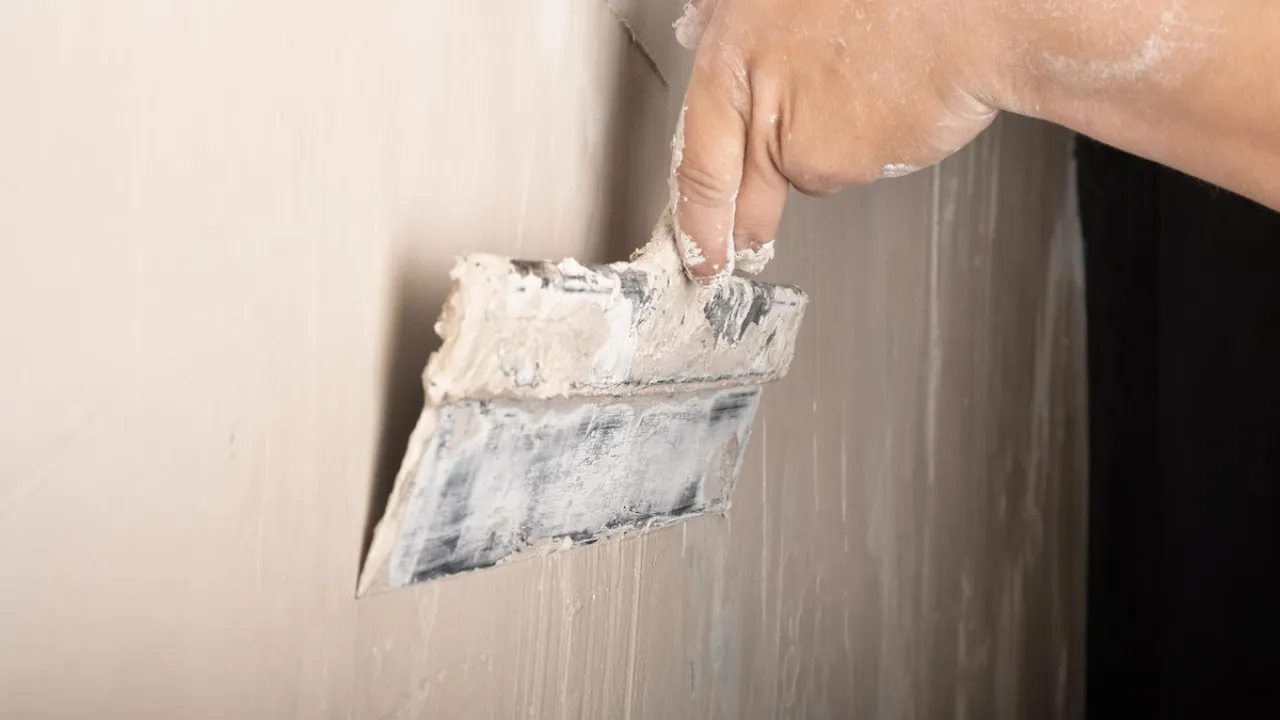If you want to achieve a wall finish that looks tidy, elegant, and aesthetic, you must first learn how to apply wall putty correctly. This technique is not only crucial at the beginning of the building process, but it also helps reduce the risk of wall cracks effectively.
If you want to learn how to do the wall putty technique, it is not difficult. You can also do it yourself, especially for finishing minor parts or doing small renovations. Are you ready to learn more useful tips to maximize results and avoid common mistakes? Read the article below until the end!
What is Wall Putty?
Wall putty is a cement-based powder product used to create a smooth surface before painting. It can help cover holes, fill in cracks, and address surface imperfections. The mixing wall putty usually contains calcium, glue, and water.
Wall putty is not only useful for new buildings, but also for covering small cracks in old walls that will be repainted. This process is highly recommended if you want a smooth wall surface and neat paint finish.
In the wall finishing process, applying wall putty is not the only process that you should do. There is also a process called skim coating. What exactly is a skim coat, and how does it differ from wall putty?
A skim coating is a process used to level the surface of walls and improve their structural integrity. The following are some differences between applying wall putty and skim coat:
- Objective: Putty a wall involves preparing the wall surface by covering small cracks and creating a smooth texture before painting. Skim coating serves the same purpose, but is more commonly used on concrete walls.
- Materials used: Wall putty uses a mixture of calcium, glue, and water. The skim coat uses a mixture of cement, fine sand, and water.
- Application method: Wall putty is applied thinly with a trowel or spatula. Skim coat, on the other hand, is applied using a trowel or other smoothing tool.
Type of Wall Putty
Wall putty is classified into several types based on its material. Below are some common types of wall putty you should know about:
1. Cement Wall Putty
Of all the types of wall putty, cement-based is one of the most commonly used for brick or concrete walls. Its cement content creates a solid surface and effectively covers fine cracks in larger areas.
If you're working on outdoor walls or areas exposed to changing weather conditions, this type of putty is an ideal solution because it is durable and resistant to moisture. Here are some key characteristics of cement-based wall putty:
- Comes in powder form with fine, clean particles.
- It offers a long-lasting finish.
- Its high silica content makes it resistant to peeling.
- It combines minerals and polymers for enhanced water resistance.
- It is suitable for both interior and exterior walls.
- It requires a longer drying time.
- It must be mixed with water at the correct ratio before application.
2. Acrylic Wall Putty
Acrylic wall putty is a water-based type of putty, It has a thick, butter-like texture. This putty is made up of white pigments, additives, preservatives, and acrylic emulsion.
It is commonly used for indoor wall applications or in areas that are not constantly exposed to water. Additionally, it is ideal for spaces that require an aesthetically pleasing finish. So, here are some of the main things you need to know about acrylic wall putty:
- Comes in a ready-to-use liquid form.
- Provides a smooth, matte finish
- It has lower adhesion strength, making it prone to peeling.
- It effectively covers old wall paint.
- It is best suited for indoor applications.
- It dries faster than other types.
- It does not require any additional materials for mixing before use.
Read also: How to Deal with Damp Walls? 7 Tips You Should Try!
How to Apply Wall Putty by Yourself with Ease
Are you planning to apply wall putty on your own? If so, take note of the following steps to ensure the best results:
1. Make Sure Your Wall Surface is Clean
Before starting to apply wall putty, it is essential to check the wall's condition for any severe cracks. Significant structural damage must be repaired before applying wall putty.
Once you have confirmed that the wall surface is ready, clean it of dust, mold, oil, and other debris. Dirt can reduce the adhesive strength of the wall putty, so it is important to do this first to ensure the putty adheres perfectly.
If you are applying putty to an old wall, the term "dirt" also includes the previous wall paint. So, you need to take off the old paint first.
2. Prepare Tools and Materials
Adjust the tools and materials to the type of wall putty you have chosen. If you plan to use cement-based wall putty, mix ready-to-use powdered putty, white glue, and clean water in a container until the mixture is smooth. Don't forget to make sure the mixture is thick and lump-free.
On the other hand, if you're planning to use acrylic-based putty, you can apply it directly without having to mix it with other materials. You'll need the same tools for both types of putty, like a trowel or a scraper.
3. Applying the Wall Putty
Then, you've gotta apply the wall putty evenly to the wall using a trowel or scraper. You can start by addressing the cracked or pitted areas first, and then smooth it out over the entire surface. For a smoother and more even finish, it is best to apply it from top to bottom.
Keep in mind that the wall putty should not be applied too thickly to avoid hairline cracks when it dries. You can repeat the application process up to two times or adjust it as needed.
4. Wait Until the Wall Putty is Completely Dry
Once you have evenly plastered the entire wall surface, leave it for about 1–2 days to allow the putty to dry completely. It is important to avoid painting while the putty is still wet. If you do, the paint will look patchy and may even peel off.
Read also: How to Treat Damp Walls, Easy and Efficient Steps!
5. Sand the Wall Surface
After the wall putty is fully dry, it is essential to double-check the results to ensure that the painting process will proceed seamlessly and adhere properly. Next, sand all wall surfaces until they are smooth and clean. You can use a cloth or vacuum cleaner to remove any remaining dust. After the wall is clean, you can start with the first layer of paint, then the second layer.
That's a brief explanation of how to properly apply wall putty. These tips can serve as a guide if you ever want to do it yourself. As you can see from the above explanation, applying wall putty is an important step in achieving a smooth wall surface and an even coat of paint.
However, you need to understand not only the method of applying wall putty, but also other stages related to the plastering process. One such stage is skim coating, which was briefly mentioned earlier.
Cement is one of the materials needed for skim coating and many other construction processes. The quality of cement plays a major role in supporting a building's strength. To get high-quality cement, you can trust Semen Merah Putih.
One of the premium quality products from Semen Merah Putih, is Semen Merah Putih Watershield that is a super multipurpose cement. With advanced water repellent technology, Semen Merah Putih Watershield provides triple protection for your wall, shielding structure from external moisture, internal dampness, and capillary water from the ground.
Semen Merah Putih Watershield is suitable for all structural and non-structural applications, including skim coating, plastering, brick laying, column casting, and slab casting. It also offers superior performance compared to regular cement.
For all your construction and renovation needs, trust Semen Merah Putih Watershield as your go-to solution. If you need more information about our products or would like a consultation to determine the right product for your needs, don’t hesitate to contact us!
Read also: 8 Elegant Grey House Paint Color Combination Inspirations



